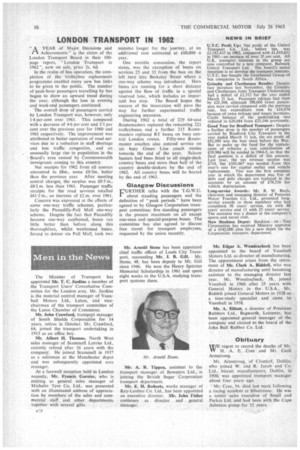LONDON TRANSPORT IN 1962
Page 38

If you've noticed an error in this article please click here to report it so we can fix it.
"A YEAR of Major Decisions and
Achievements" is the claim of the London Transport Board in their 100page report, "London Transport in 1462 ", now on sale, price 2s. 6d.
In the realm of bus operation, the completion of the trolleybus replacement programme enabled many new bus links to be given to the public. The number of peak-hour passengers travelling by bus began to show an upward trend during the year, although the loss in evening and week-end passengers continued.
The overall drop of passengers carried by London Transport was, however, only 1.4 per cent over 1961. This compared with a decrease of 4.6 per cent and 2.1 per cent over the previous year for 1960 and 1961 respectively. The improvement was attributed to better operation of road services due to a reduction in staff shortage and less traffic congestion, and an unusually large rise in population in the Board's area caused by Commonwealth immigrants coming to this country.
Net receipts for 1962 from all sources amounted to f8m., some £0-3m. better than the previous year. After meeting central charges, the surplus was £0-5 m., £0.2 m. less than 1961. Passenger traffic receipts for the road services totalled £61.2 m., an increase of £2 m. over 1961.
Concern was expressed at the effects of some one-way traffic schemes, particularly the Piccadilly-Pall Mall one-way scheme. Despite the fact that Piccadilly became one-way eastbound, buses ran little better than before along this thoroughfare, whilst westbound buses. forced to detour via Pall Mall, took two minutes longer for the journey, at an additional cost estimated at £60,000 a year.
One notable concession, the report states, was the exemption of buses on services 25 and 32 from the ban on the left turn into Berkeley Street where a one-way scheme was introduced. Here buses are running for a short distance against the flow of traffic in a special reserved lane, which includes an important bus stop. The Board hopes the success of the innovation will pave the way for further experimental traffic engineering measures.
During 1962 a total of 229 64-seat Routemasters replaced the remaining 221 trolleybuses and a further 215 Routemasters replaced RT buses on busy central London routes. Fifty-two Routemaster coaches also entered service on six busy Green Line poach routes towards the end of the year. Saloon heaters had been fitted to all single-deck country buses and more than half of the country double-deckers by the end of 1962. All country buses will be heated by the end of 1963.
Glasgow Discussions FURTHER talks with the T.G.W.U. about standing passengers and the definition of "peak periods" have been agreed to by Glasgow Corporation transport committee; five standing passengers is the present maximum on all except one-man and special-purpose buses. The committee has also agreed to discuss free travel for transport employees, requested by the union recently.




































































































